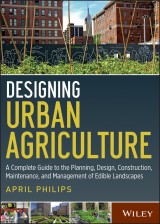Details

Designing Urban Agriculture
A Complete Guide to the Planning, Design, Construction, Maintenance and Management of Edible Landscapes1. Aufl.
|
68,99 € |
|
| Verlag: | Wiley |
| Format: | EPUB |
| Veröffentl.: | 10.05.2013 |
| ISBN/EAN: | 9781118330234 |
| Sprache: | englisch |
| Anzahl Seiten: | 288 |
DRM-geschütztes eBook, Sie benötigen z.B. Adobe Digital Editions und eine Adobe ID zum Lesen.
Beschreibungen
<p><b>A comprehensive overview of edible landscapes—complete with more than 300 full-color photos and illustrations</b></p> <p><i>Designing Urban Agriculture</i> is about the intersection of ecology, design, and community. Showcasing projects and designers from around the world who are forging new paths to the sustainable city through urban agriculture landscapes, it creates a dialogue on the ways to invite food back into the city and pave a path to healthier communities and environments.</p> <p>This full-color guide begins with a foundation of ecological principles and the idea that the food shed is part of a city's urban systems network. It outlines a design process based on systems thinking and developed for a lifecycle or regenerative-based approach. It also presents strategies, tools, and guidelines that enable informed decisions on planning, designing, budgeting, constructing, maintaining, marketing, and increasing the sustainability of this re-invented cityscape. Case studies demonstrate the environmental, economic, and social value of these landscapes and reveal paths to a greener and healthier urban environment.</p> <p>This unique and indispensable guide:</p> <ul> <li>Details how to plan, design, fund, construct, and leverage the sustainability aspects of the edible landscape typology</li> <li>Covers over a dozen typologies including community gardens, urban farms, edible estates, green roofs and vertical walls, edible school yards, seed to table, food landscapes within parks, plazas, streetscapes and green infrastructure systems and more</li> <li>Explains how to design regenerative edible landscapes that benefit both community and ecology and explores the connections between food, policy, and planning that promote viable food shed systems for more resilient communities</li> <li>Examines the integration of management, maintenance, and operations issues</li> <li>Reveals how to create a business model enterprise that addresses a lifecycle approach</li> </ul>
<p>Preface vii</p> <p>Acknowledgments ix</p> <p><b>Chapter 1 Food Cities: Ecology + Urban Agriculture 1</b></p> <p>Lafayette Greens, Detroit 1</p> <p>Bar Agricole, San Francisco 10</p> <p>City Slicker Farms, Oakland 13</p> <p>Viet Village, New Orleans 29</p> <p>Big City Farms, Baltimore 38</p> <p><b>Chapter 2 Planning Strategies for Urban Food Systems 41</b></p> <p>Prairie Crossing, Grayslake 41</p> <p>River Falls Eco Village, River Falls 51</p> <p>Verge Sidewalk Garden, Charlottesville 75</p> <p>Scent of Orange, Chongqing 80</p> <p><b>Chapter 3 Vision, Synthesis, and Form 87</b></p> <p>Villa Augustus, Dordrecht 87</p> <p>Miller Creek Edible Garden and Outdoor Kitchen, San Rafael 104</p> <p>2001 Market Street, San Francisco 109</p> <p>Gary Comer Youth Center, Chicago 117</p> <p><b>Chapter 4 Systems Integration and Connections 133</b></p> <p>Medlock Ames Wine Tasting Room, Healdsburg 133</p> <p>Our School at Blair Grocery, New Orleans 144</p> <p>Incredible Edible House, prototype 156</p> <p>Science Barge, Yonkers, New York 167</p> <p>Banyan Street Manor, Honolulu 177</p> <p><b>Chapter 5 Lifecycle Operations 181</b></p> <p>Die Plantage, Munich 181</p> <p>MUSC Urban Fram, Charleston 191</p> <p>Riverpark Farm, Manhattan 202</p> <p>VF Outdoors Campus, Alameda 209</p> <p>Sacred Heart Organic Garden, Atherton 218</p> <p>Slow Food Nation Victory Garden, San Francisco 224</p> <p><b>Chapter 6 Outreach and Community 227</b></p> <p>Atlanta Botanical Garden, Atlanta 227</p> <p>Urban Food Jungle, prototype 235</p> <p>Expo 2015, Milan 239</p> <p>Alemany Farms, San Francisco 250</p> <p>P-Patch Gardens, Seattle 253</p> <p>Glide Church, San Francisco 259</p> <p>Gotham Greens, Brooklyn 261</p> <p>Bibliography 267</p> <p>Image credits 271</p> <p>Index 273</p>
<p><b>APRIL PHILIPS, RLA, FASLA,</b> is founder and principal of April Philips Design Works, an award-winning Bay Area firm that specializes in landscape architecture and urban ecology. Her notable projects include Union Square, Santana Row, Peet's Coffee and Tea Roasting Facility, 2001 Market Street, VF Outdoor Campus, and Oakland Memorial Park. Her recent work includes the incorporation of urban edibles and increasing habitat in the urban realm.</p>
<p><b>A comprehensive overview of edible landscapes—complete with more than 300 full-color photos and illustrations</b></p> <p><i>Designing Urban Agriculture</i> is about the intersection of ecology, design, and community. Showcasing projects and designers from around the world who are forging new paths to the sustainable city through urban agriculture landscapes, it creates a dialogue on the ways to invite food back into the city and pave a path to healthier communities and environments.</p> <p>This full-color guide begins with a foundation of ecological principles and the idea that the food shed is part of a city's urban systems network. It outlines a design process based on systems thinking and developed for a lifecycle or regenerative-based approach. It also presents strategies, tools, and guidelines that enable informed decisions on planning, designing, budgeting, constructing, maintaining, marketing, and increasing the sustainability of this re-invented cityscape. Case studies demonstrate the environmental, economic, and social value of these landscapes and reveal paths to a greener and healthier urban environment.</p> <p>This unique and indispensable guide:</p> <ul> <li>Details how to plan, design, fund, construct, and leverage the sustainability aspects of the edible landscape typology</li> <li>Covers over a dozen typologies including community gardens, urban farms, edible estates, green roofs and vertical walls, edible school yards, seed to table, food landscapes within parks, plazas, streetscapes and green infrastructure systems and more</li> <li>Explains how to design regenerative edible landscapes that benefit both community and ecology and explores the connections between food, policy, and planning that promote viable food shed systems for more resilient communities</li> <li>Examines the integration of management, maintenance, and operations issues</li> <li>Reveals how to create a business model enterprise that addresses a lifecycle approach</li> </ul>

















